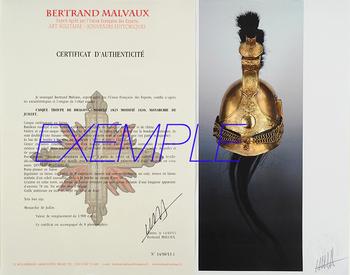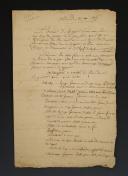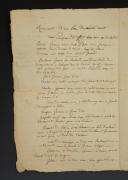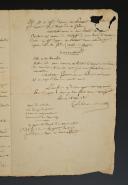
Imperial Guard. 2nd Regiment of Young Guard Hunters: ORDER OF THE DAY OF MAY 27, 1815 SIGNED BY CHARLES LEFEBVRE-DESNOUETTES, ANNOUNCING THE NAME AND UNIFORM OF THIS REGIMENT. 18907-16
Sold out
Imperial Guard. 2nd Regiment of Young Guard Chasseurs: ORDER OF THE DAY OF MAY 27, 1815 SIGNED BY CHARLES LEFEBVRE-DESNOUETTES, ANNOUNCING THE DESIGNATION AND UNIFORM OF THIS REGIMENT. 18907-16
Handwritten document, very detailed.
Order of the day of May 27, 1815 signed by C. Lefebvre-Desnouettes:
"The Colonel of the Regiment announces with pleasure to the Cavalry Corps of the Young Guard, that His Majesty, in reward for the good conduct rendered, the arrangements made for the new recruits in this Regiment, is pleased to give it the designation of: 2nd Regiment of Young Guard Chasseurs.
By this favor, the Emperor also wishes to reward the Bravest of the Young Guard who fought in the last campaigns with such bravery & heroism in this same Regiment.
His Majesty has determined the uniform of the 2nd Regiment as follows [...]."
The rest of the text describes in detail the complete uniform and equipment of this Young Guard.
Handwritten note at the end of the text: "A copy of this order will be sent immediately to Colonel Assant, commanding at Chantilly."
Double sheet. 3 pages. Height 34 cm x 22.7 cm.
In fair condition, frayed edges, folds, tears with missing parts on the last page (a word is missing in the text).
BIOGRAPHY:
Charles Lefebvre-Desnouettes, born on September 14, 1773 in Paris and died on April 22, 1822 off the coast of Ireland, was a French general of the Revolution and the Empire. He was also the president of the Vine and Olive Colony in Alabama.
[...] During the Hundred Days on March 9, 1815, with his regiment from Cambrai, he joined Napoleon. Made a peer of France, Lefebvre-Desnouettes took command of the light cavalry of the Old Guard and fought at Ligny on June 15 and at Quatre-Bras on June 16. He charged at Waterloo on the 18th and then retreated to the Loire.
HISTORICAL BACKGROUND:
The chasseurs à cheval (light cavalry) of the Young Guard, officially created in 1815 under the name 2nd Regiment of Chasseurs à Cheval of the Imperial Guard and nicknamed the hussar-scouts, were a unit of light cavalry of the Imperial Guard, formed by Napoleon I and in service in the French army from 1813 to 1814, as well as during the Hundred Days. The decree of March 6, 1813, gives the 6th, 7th, 8th, and 9th squadrons of chasseurs à cheval of the Guard the designation of "second chasseurs". On March 17, these squadrons officially adopted the name Chasseurs à Cheval of the Young Guard. They participated in the 1813 campaign in Germany with the Old Guard, then were detached in 1814 to the Northern Army commanded by General Nicolas-Joseph Maison. The squadrons were disbanded during the First Restoration, with most men being reassigned to the line cavalry. During the Hundred Days, the squadrons of the Young Guard were recalled and formed the 2nd Regiment of Chasseurs à Cheval of the Imperial Guard. Lacking men and especially horses, the unit remained at Chantilly and did not participate in the Battle of Waterloo. The chasseurs à cheval of the Young Guard were definitively disbanded on October 26, 1815, after Napoleon's abdication and the return of the Bourbons.
Handwritten document, very detailed.
Order of the day of May 27, 1815 signed by C. Lefebvre-Desnouettes:
"The Colonel of the Regiment announces with pleasure to the Cavalry Corps of the Young Guard, that His Majesty, in reward for the good conduct rendered, the arrangements made for the new recruits in this Regiment, is pleased to give it the designation of: 2nd Regiment of Young Guard Chasseurs.
By this favor, the Emperor also wishes to reward the Bravest of the Young Guard who fought in the last campaigns with such bravery & heroism in this same Regiment.
His Majesty has determined the uniform of the 2nd Regiment as follows [...]."
The rest of the text describes in detail the complete uniform and equipment of this Young Guard.
Handwritten note at the end of the text: "A copy of this order will be sent immediately to Colonel Assant, commanding at Chantilly."
Double sheet. 3 pages. Height 34 cm x 22.7 cm.
In fair condition, frayed edges, folds, tears with missing parts on the last page (a word is missing in the text).
BIOGRAPHY:
Charles Lefebvre-Desnouettes, born on September 14, 1773 in Paris and died on April 22, 1822 off the coast of Ireland, was a French general of the Revolution and the Empire. He was also the president of the Vine and Olive Colony in Alabama.
[...] During the Hundred Days on March 9, 1815, with his regiment from Cambrai, he joined Napoleon. Made a peer of France, Lefebvre-Desnouettes took command of the light cavalry of the Old Guard and fought at Ligny on June 15 and at Quatre-Bras on June 16. He charged at Waterloo on the 18th and then retreated to the Loire.
HISTORICAL BACKGROUND:
The chasseurs à cheval (light cavalry) of the Young Guard, officially created in 1815 under the name 2nd Regiment of Chasseurs à Cheval of the Imperial Guard and nicknamed the hussar-scouts, were a unit of light cavalry of the Imperial Guard, formed by Napoleon I and in service in the French army from 1813 to 1814, as well as during the Hundred Days. The decree of March 6, 1813, gives the 6th, 7th, 8th, and 9th squadrons of chasseurs à cheval of the Guard the designation of "second chasseurs". On March 17, these squadrons officially adopted the name Chasseurs à Cheval of the Young Guard. They participated in the 1813 campaign in Germany with the Old Guard, then were detached in 1814 to the Northern Army commanded by General Nicolas-Joseph Maison. The squadrons were disbanded during the First Restoration, with most men being reassigned to the line cavalry. During the Hundred Days, the squadrons of the Young Guard were recalled and formed the 2nd Regiment of Chasseurs à Cheval of the Imperial Guard. Lacking men and especially horses, the unit remained at Chantilly and did not participate in the Battle of Waterloo. The chasseurs à cheval of the Young Guard were definitively disbanded on October 26, 1815, after Napoleon's abdication and the return of the Bourbons.
Reference :
18907-16

Next update Friday, december 12 at 13:30 PM
FOR ALL PURCHASES, PAYMENT IN MULTIPLE CHECKS POSSIBLE
bertrand.malvaux@wanadoo.fr 06 07 75 74 63
SHIPPING COSTS
Shipping costs are calculated only once per order for one or more items, all shipments are sent via registered mail, as this is the only way to have proof of dispatch and receipt.
For parcels whose value cannot be insured by the Post, shipments are entrusted to DHL or Fedex with real value insured, the service is of high quality but the cost is higher.
RETURN POLICY
Items can be returned within 8 days of receipt. They must be returned by registered mail at the sender's expense, in their original packaging, and in their original condition.
AUTHENTICITY
The selection of items offered on this site allows me to guarantee the authenticity of each piece described here, all items offered are guaranteed to be period and authentic, unless otherwise noted or restricted in the description.
An authenticity certificate of the item including the description published on the site, the period, the sale price, accompanied by one or more color photographs is automatically provided for any item priced over 130 euros. Below this price, each certificate is charged 5 euros.
Only items sold by me are subject to an authenticity certificate, I do not provide any expert reports for items sold by third parties (colleagues or collectors).
FOR ALL PURCHASES, PAYMENT IN MULTIPLE CHECKS POSSIBLE
bertrand.malvaux@wanadoo.fr 06 07 75 74 63
An authenticity certificate of the item including the description published on the site, the period, the sale price, accompanied by one or more color photographs is automatically provided for any item priced over 130 euros. Below this price, each certificate is charged 5 euros.
Only items sold by me are subject to an authenticity certificate, I do not provide any expert reports for items sold by third parties (colleagues or collectors).


